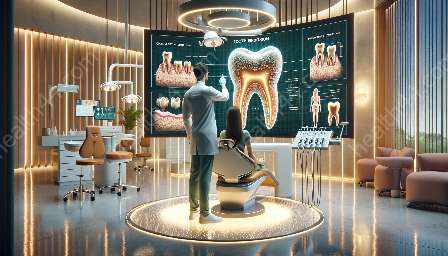Gastroesophageal reflux disease (GERD) can have significant implications for oral health, leading to dental complications such as tooth erosion. Understanding the technology and diagnostic tools available for assessing these issues is crucial in providing effective care for patients with GERD.
Understanding GERD-Associated Dental Complications
GERD is a chronic condition characterized by the backward flow of stomach acid into the esophagus. The acidic contents can also make their way into the oral cavity, leading to dental complications. One of the most common issues is tooth erosion, which occurs when the enamel on the teeth is worn down by acid exposure.
Aside from tooth erosion, GERD can also contribute to other dental problems such as increased tooth sensitivity, dry mouth, and an increased risk of cavities. These complications can significantly impact a patient's quality of life and may require comprehensive dental care.
Diagnostic Tools for Assessing GERD-Associated Dental Complications
Advancements in dental technology have facilitated the diagnosis and assessment of dental complications associated with GERD. Dentists and oral health professionals have access to a range of tools and techniques to evaluate the extent of damage and develop appropriate treatment plans.
Dental Imaging
Technology such as intraoral cameras, digital X-rays, and cone beam computed tomography (CBCT) can provide detailed images of the teeth and surrounding structures, allowing dentists to identify signs of erosion and other GERD-related issues. These imaging tools are instrumental in accurately assessing the extent of damage and monitoring changes over time.
pH Monitoring
pH monitoring devices can be used to measure the acidity levels in the oral cavity. This is particularly useful in identifying areas of the mouth that are most affected by acid exposure and can help in determining the severity of tooth erosion. By understanding the pH dynamics, dentists can tailor treatment strategies to address specific areas of concern.
Salivary Tests
Saliva plays a crucial role in buffering acids and maintaining oral health. Salivary tests can help in assessing the quality and quantity of saliva, providing insights into the patient's saliva production and its protective effects. Understanding salivary composition can guide dental professionals in recommending appropriate interventions to manage GERD-related dental complications.
Technological Interventions for Managing GERD-Associated Dental Complications
Aside from diagnostic tools, technology also plays a vital role in managing GERD-associated dental complications. Advances in dental materials and treatment modalities have offered innovative solutions for restoring and preserving dental structures affected by acid exposure.
Dental Restorations
Materials such as composite resins and glass ionomer cements are used to restore eroded teeth, providing both functional and aesthetic benefits. These restorations can help to rebuild tooth structure and protect against further damage caused by acid erosion.
Protective Coatings and Sealants
Specialized dental coatings and sealants are available to provide additional protection to teeth vulnerable to acid exposure. These materials create a barrier between the acid and the tooth surface, helping to mitigate the effects of GERD on dental health.
Customized Oral Appliances
For individuals with severe GERD who experience nighttime reflux, customized oral appliances can be prescribed to prevent acid from reaching the oral cavity. These devices can help to minimize acid-related damage to the teeth and oral tissues, thereby preserving oral health.
Collaborative Approach and Patient Education
Given the multifaceted nature of GERD-associated dental complications, a collaborative approach involving gastroenterologists, dentists, and other healthcare providers is essential. By working together, healthcare professionals can develop comprehensive care plans that address both the gastrointestinal aspects of GERD and its impact on oral health.
Patient education also plays a key role in managing GERD-associated dental complications. By raising awareness about the connection between GERD and dental issues, patients can take proactive steps to minimize acid exposure, such as modifying their diet, improving oral hygiene practices, and adhering to prescribed treatments for GERD.
Conclusion
Technology and diagnostic tools have revolutionized the way dental professionals assess and manage GERD-associated dental complications, particularly tooth erosion. By leveraging advanced imaging, pH monitoring, and salivary tests, dentists can gain valuable insights into the extent of damage and tailor treatment plans to meet individual patient needs. Furthermore, technological interventions such as dental restorations, protective coatings, and customized oral appliances offer innovative solutions for preserving oral health in patients with GERD. Through a collaborative approach and patient education, healthcare providers can work towards mitigating the impact of GERD on oral health and improving the overall well-being of affected individuals.


